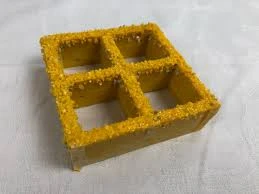loading...
- No. 9, Xingyuan South Street, Dongwaihuan Road, Zaoqiang County, Hengshui, Hebei, China
- admin@zjcomposites.com
- +86 15097380338
- Welcome to visit our website!
frp floor grating
Understanding FRP Floor Grating A Versatile Solution for Industrial Applications
Fiber Reinforced Polymer (FRP) floor grating is an innovative solution that has gained significant attention in various industries due to its unique properties and advantages. Unlike traditional materials such as steel or fiberglass, FRP grating combines advanced composite materials, offering a lightweight, durable, and corrosion-resistant alternative that excels in demanding environments.
Understanding FRP Floor Grating A Versatile Solution for Industrial Applications
Safety is another critical aspect where FRP grating excels. Many FRP grating products come with non-slip surfaces, providing superior traction even in wet or oily conditions. This feature is particularly important for pedestrian walkways and work platforms, where slip hazards can lead to serious workplace accidents. Additionally, the inherent properties of FRP contribute to lower maintenance costs over time, as it does not rust, corrode, or splinter like its metal counterparts.
frp floor grating

The design flexibility offered by FRP grating is yet another advantage worth noting. Manufacturers can produce grating in various shapes, sizes, and colors to meet specific project requirements. This adaptability ensures that customers can find a solution that suits not only their functional needs but also their aesthetic preferences. With the ability to integrate different styles and configurations, FRP grating can enhance the overall look of industrial spaces without compromising functionality.
Moreover, FRP floor grating contributes to sustainability efforts in construction and manufacturing. The materials used in FRP production can often include recycled components, making it a more environmentally friendly option compared to traditional building materials. By choosing FRP grating, companies can reduce their carbon footprint and align with green building initiatives.
However, it is important to recognize that while FRP grating presents numerous advantages, it may not be suitable for every application. It is recommended to consult with engineering professionals to evaluate specific project needs and conduct proper assessments before making a decision.
In conclusion, FRP floor grating stands out as a versatile and effective solution for a wide range of industrial applications. Its lightweight nature, durability, safety features, design flexibility, and environmental benefits make it an attractive option for companies looking to enhance operational efficiency while maintaining safety standards. As industries continue to evolve and face new challenges, the demand for innovative materials like FRP grating is likely to grow, paving the way for a more sustainable and efficient future in industrial infrastructure. Whether you are upgrading existing facilities or designing new ones, consider the long-term benefits and advantages that FRP floor grating can bring to your operations.
-
GRP Structures: The Future of Lightweight, High-Performance EngineeringNewsJun.20,2025
-
FRP Water Tank: High-Performance Storage for Corrosive and Clean Water SystemsNewsJun.20,2025
-
FRP Square Tube: The New Industry Standard for Chemical and Structural ApplicationsNewsJun.20,2025
-
FRP Pultruded Profiles: The Ultimate Choice for Lightweight Structural StrengthNewsJun.20,2025
-
FRP Handrails: The Safer, Smarter, and Stronger Choice for Modern InfrastructureNewsJun.20,2025
-
FRP Grating: The Smart Solution for Durable, Lightweight Industrial FlooringNewsJun.20,2025
-
Why Choose a Galvanized Water Tank for Your Storage NeedsNewsMay.21,2025
